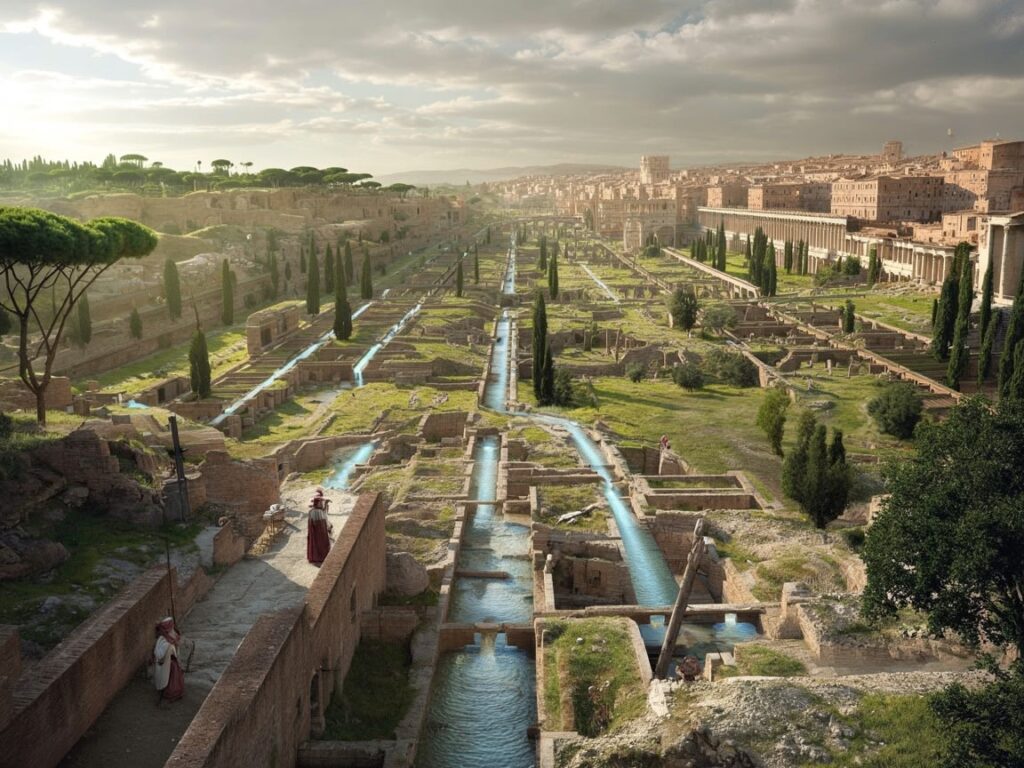Ancient Rome faced significant public health challenges, including plagues and pandemics that influenced its history. Examining how Rome dealt with these crises offers valuable lessons in early public health strategies.
In this article, we will explore:
- The public health challenges faced by Ancient Rome
- The importance of understanding Roman responses to plagues and pandemics
- The lessons we can learn from Rome’s approach to public health emergencies
The daily life in Ancient Rome varied greatly among different social classes, particularly during public health crises. The patricians and plebeians experienced these challenges in distinct ways, shaping their daily routines and traditions.
Additionally, the religious practices of the Romans played a crucial role during these crises. Religion was not just a belief system but a comprehensive framework that influenced every aspect of their lives, including their responses to pandemics.
The historical context of the rise and fall of the Roman Empire also sheds light on how public health issues were addressed. This ancient civilization has had a lasting impact on the world, shaping politics, culture, and society in ways that are still relevant today.
Finally, understanding the legal status of Roman women during these health crises reveals a complex web of rights and restrictions that significantly affected gender dynamics in ancient Rome. Their citizenship was closely tied to their relationships with men, such as fathers or husbands, which further complicated their experiences during public health emergencies.
Historical Context of Public Health Crises in Rome
Kingdom Period
During the Kingdom period, Rome faced public health challenges primarily related to poor sanitation and overcrowding. Disease outbreaks were common due to limited understanding of hygiene practices, particularly among the plebeians, who made up the majority of the population and lived in these overcrowded conditions.
Republic Period
Transitioning into the Republic period, public health concerns persisted, exacerbated by frequent warfare and expanding territories leading to increased contact with new diseases. The Roman Republic saw outbreaks of malaria, typhoid fever, and other infectious illnesses. The impact of these health crises was felt across all social strata, including the patricians, who although wealthy, were not immune to these diseases.
Empire Period
As Rome evolved into the Empire period, public health measures became more sophisticated. The historical evolution of public health challenges in Rome showcases a gradual improvement in understanding disease transmission and prevention strategies. The Antonine Plague, believed to be smallpox or measles, ravaged the empire from 165-180 AD, demonstrating the vulnerability of Rome to pandemics despite advancements in medicine and infrastructure.
Each period presented unique obstacles and responses that shaped Rome’s approach to public health crises, culminating in the empire’s ability to implement more comprehensive measures during widespread pandemics like the Antonine Plague.

Sanitation Infrastructure as a Preventative Measure
Sanitation infrastructure played a crucial role in ancient Rome’s public health initiatives, emphasizing cleanliness and disease prevention:
1. Roman Sanitation Systems
The aqueducts provided a steady supply of clean water to the population, promoting better hygiene practices. This is just one example of how Roman architecture served functional purposes while also showcasing their engineering prowess.
2. Cloaca Maxima Sewer System
This advanced sewer system efficiently managed waste disposal, reducing environmental contamination and the spread of infections.
These infrastructures were vital in controlling the transmission of diseases and maintaining public health standards in Rome. The effectiveness of these systems can be attributed to the complex political structure established during the Roman Republic, which laid the foundation for modern governance and facilitated such large-scale public health initiatives.

Medical Practices and Healthcare Provision in Ancient Rome
Roman medicine in Ancient Rome was characterized by a combination of advanced practices and traditional beliefs. One significant aspect was the establishment of valetudinaria, which were hospitals primarily catering to soldiers and slaves but eventually extending their services to citizens. These medical facilities played a crucial role in providing care during public health crises.
Moreover, the appointment of community doctors during the Roman Empire marked a pivotal advancement in healthcare provision. These physicians were responsible for overseeing hygiene practices, identifying infections early on, and implementing preventive measures to control disease spread within communities.
The integration of pharmacology, dietetics, and surgery in Roman medical practices showcased a holistic approach to healthcare. Physicians like Antonius Musa and Scribonius Largus made notable contributions to medical knowledge during this period. These practitioners utilized various treatment approaches to address a wide range of ailments prevalent during plagues and pandemics, emphasizing the importance of comprehensive care strategies in combating public health crises.
In addition to these medical advancements, the Roman roads, which facilitated the movement of goods and people across the empire, also played a significant role in the healthcare system. The improved connectivity allowed for better distribution of medical supplies and easier access to healthcare facilities.
Furthermore, the rich art and culture of Ancient Rome also influenced its medical practices. Artistic representations often depicted medical procedures and health-related themes, reflecting the society’s understanding and perception of medicine at that time.

The Antonine Plague: A Case Study on Roman Public Health Response
The Antonine Plague struck the Roman Empire between 165 and 180 AD, representing one of the deadliest pandemics in ancient history. Believed to be caused by either smallpox or measles, this epidemic had a staggering impact on population and military strength.
Key characteristics of the Antonine Plague include:
- Massive mortality impact: Estimates suggest that millions perished, with some sources indicating up to 5 million deaths across the empire.
- Military weakening: The Roman army suffered significant losses, undermining its ability to defend and expand borders. This military might was crucial for the empire’s expansion and defense.
- Spread via troops: The disease likely entered Rome through soldiers returning from campaigns in the Near East, illustrating early examples of how military movements influence epidemic spread.
- Symptoms described: Contemporary accounts mention fever, diarrhea, skin eruptions, and respiratory distress consistent with smallpox or measles.
- Social disruption: High mortality led to labor shortages and economic strain, affecting urban centers and rural areas alike.
Roman authorities faced unprecedented challenges in managing this crisis. Unlike earlier outbreaks, the Antonine Plague exposed vulnerabilities in public health preparedness despite existing sanitation and medical efforts. The scale of death forced adaptations in military recruitment and civilian governance.
This pandemic marks a defining moment in Roman history where disease directly influenced political stability and societal structure. Its effects rippled through subsequent decades, shaping responses to future public health emergencies.
Moreover, it is important to note that the engineering feats of the Romans played a significant role in their ability to manage such crises. Their advanced infrastructure not only facilitated military movements but also helped in the effective governance during times of social disruption.
Additionally, understanding the transition from monarchy to a republican system during this period can provide valuable insights into how political structures were affected by such pandemics. This shift is detailed in our article about the birth of the Roman Republic, which marks a pivotal moment in history with enduring impacts on modern political structures.

Legal, Urban Planning, and Religious Responses to Epidemics in Ancient Rome
In Ancient Rome, various measures were implemented to combat the threat of epidemics. These responses encompassed legal regulations, urban planning initiatives, and religious practices aimed at safeguarding public health.
1. Laws Mandating Cremation Outside City Borders
To mitigate the risk of contagion, Romans enacted public health laws that required the cremation of deceased individuals outside the city limits. This measure aimed to prevent the spread of contagious diseases within densely populated areas by reducing the risk of infection from burial sites.
2. Urban Planning Incorporating Hygiene Considerations
Urban planners in Ancient Rome integrated hygiene practices into city design to mitigate the transmission of diseases. Factors such as waste management, water supply sources, and proximity of public spaces were carefully considered to promote public health and prevent epidemics.
3. Use of Religious Ceremonies Seeking Protection from Plagues
During times of epidemics, Romans turned to religious rituals as a form of seeking divine protection against plagues. Ceremonies, prayers, and offerings were conducted in temples and sacred sites to appease deities and ward off diseases believed to be of supernatural origin.
This multifaceted approach involving legal mandates, urban planning strategies, and religious practices highlights the comprehensive nature of Roman responses to public health crises.
Early Christian Influence During Epidemics: A Different Approach to Public Health Crisis Management
Early Christians distinguished themselves in how they responded to plagues and pandemics. Their approach centered on nursing the sick with compassion and care, which differed markedly from prevailing Roman attitudes that often shunned the ill due to fear of contagion. This hands-on involvement not only comforted the afflicted but also contributed to lower mortality rates during outbreaks.
Key aspects of early Christian responses include:
- Personal care for the sick: Christians provided food, hygiene assistance, and emotional support, recognizing the dignity of each individual.
- Community organization: Networks within Christian groups mobilized resources efficiently to sustain care even under epidemic pressures.
- Moral imperative: Their actions were motivated by religious teachings emphasizing love, charity, and service, fostering resilience in affected communities.
This compassionate model of public health management created a social safety net that helped mitigate the impacts of disease while expanding Christian influence across Rome. It introduced an early form of organized caregiving during crises, contrasting sharply with state-centered efforts—often influenced by Roman mythology—and laying groundwork for future healthcare traditions.

Lessons from Ancient Rome for Modern Public Health Crisis Management Strategies
The Roman experience highlights the critical role of public health infrastructure investment. Aqueducts, sewer systems, and valetudinaria were not luxury projects but essential tools for controlling disease spread. These infrastructures functioned as the backbone of preventive measures, demonstrating how robust sanitation and healthcare facilities can mitigate the impact of pandemics.
Key takeaways for today’s pandemic preparedness include:
- Infrastructure as prevention: Maintaining clean water supplies and effective waste management reduces infection transmission at the source.
- Healthcare accessibility: Establishing dedicated medical facilities and appointing professionals to monitor public health improves early detection and treatment outcomes.
- Integrated strategies: Combining urban planning, legal frameworks, and community involvement forms a comprehensive defense against epidemics.
Ancient Rome’s approach reveals that investing in these areas is not only a response mechanism but a proactive strategy that strengthens societal resilience. For instance, the entertainment in Ancient Rome played a significant role in society, influencing social relationships and political authority.
Moreover, the legacy of Ancient Rome continues to shape Western civilization today. This includes the enduring influence of the [Corpus Juris Civilis](https://www.menofpompeii.com/the-enduring-influence-of-the-corpus-juris-civilis-on-modern-law), a significant achievement in the history of law commissioned by Emperor Justinian I.
Additionally, exploring the rise of Stoicism in Rome reveals how Greek philosophy shaped Roman thought, which can provide valuable insights into modern public health strategies.
Modern public health systems benefit from remembering these lessons, ensuring preparedness is built on solid foundational infrastructure rather than reactive measures alone.
Conclusion
The public health legacy of ancient Rome offers valuable insights for today’s challenges. Understanding Plagues and Pandemics: How Rome Responded to Public Health Crises reveals critical lessons:
- Investment in sanitation and healthcare infrastructure remains essential.
- Coordinated legal, medical, and social strategies improve epidemic control.
- Compassionate community care can reduce mortality and strengthen societal resilience.
Applying these ancient Rome lessons encourages a balanced approach between technology, governance, and human compassion. History reminds you that preparedness and adaptability are timeless tools against public health threats.

